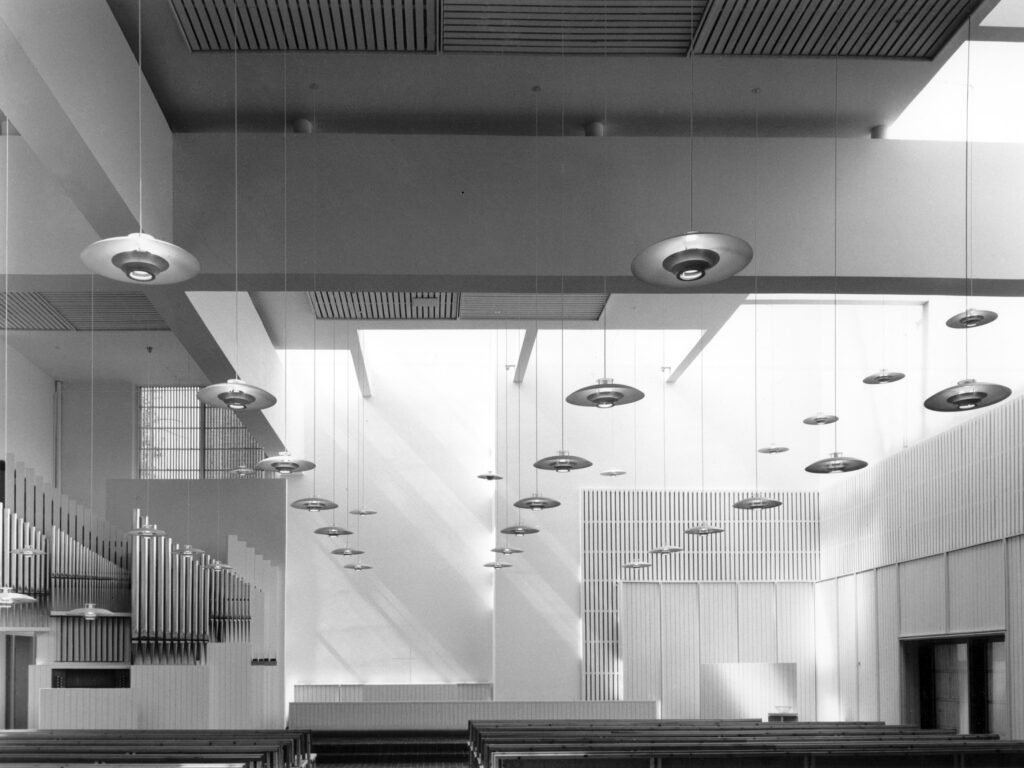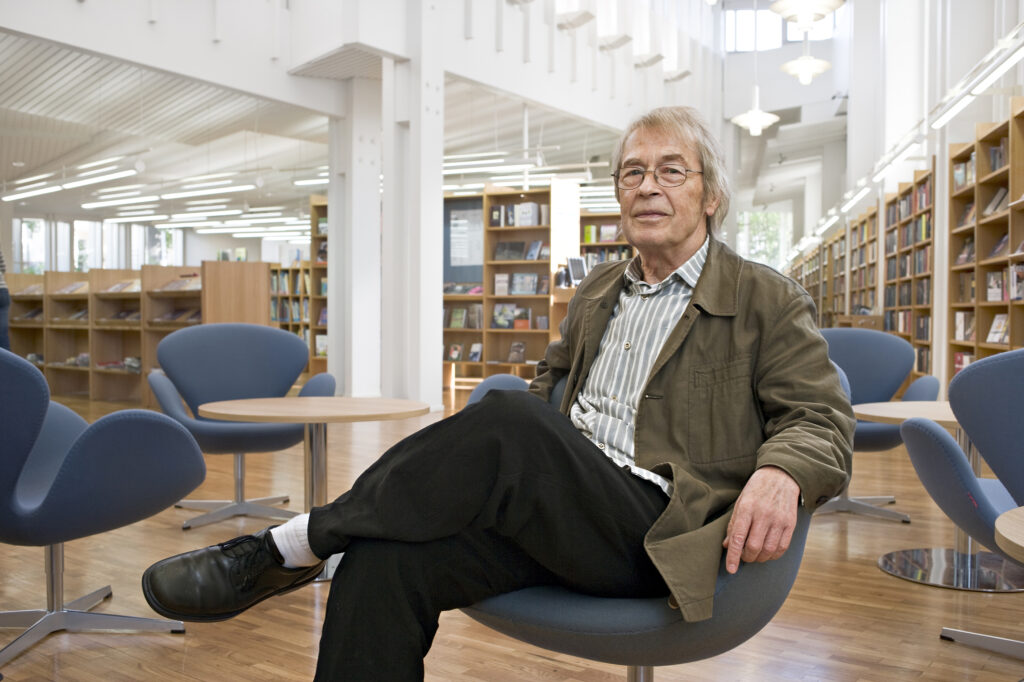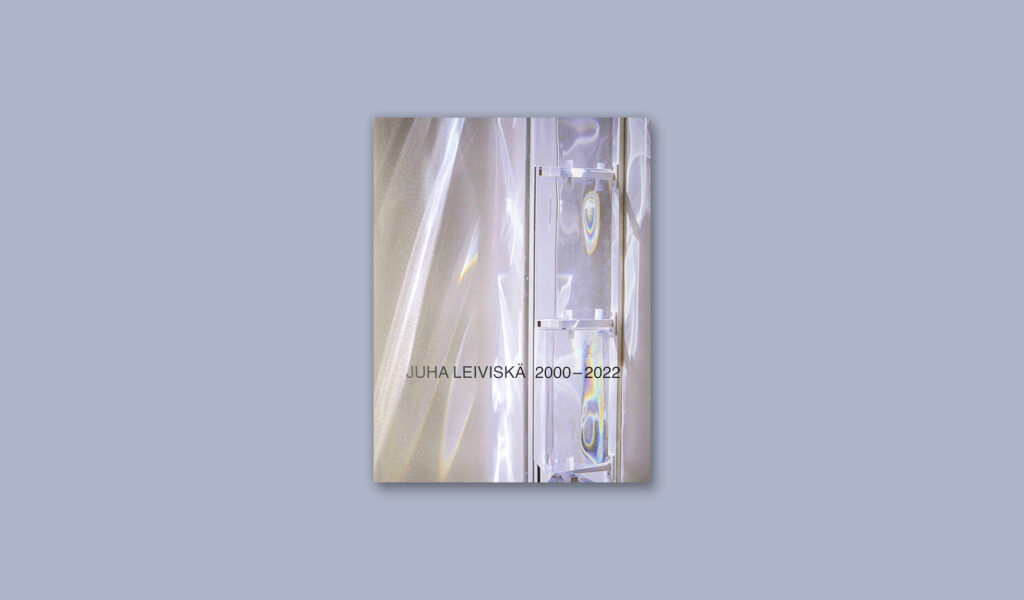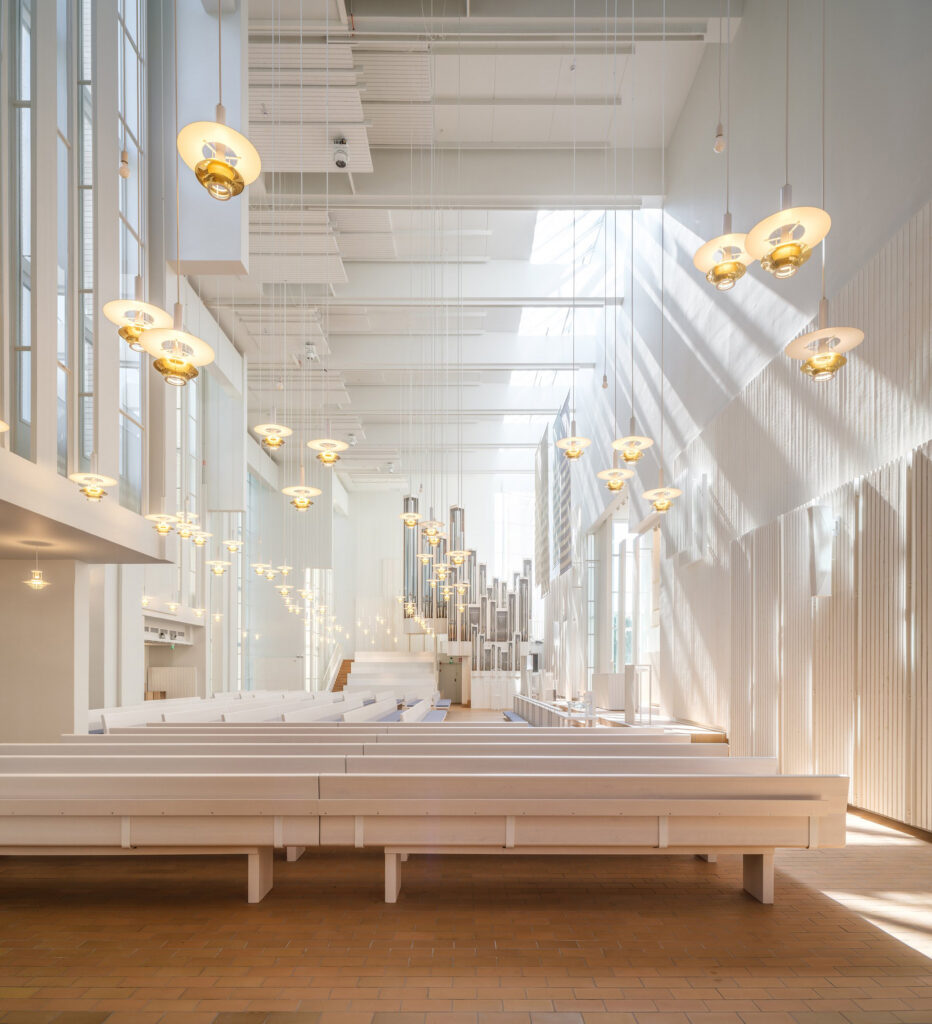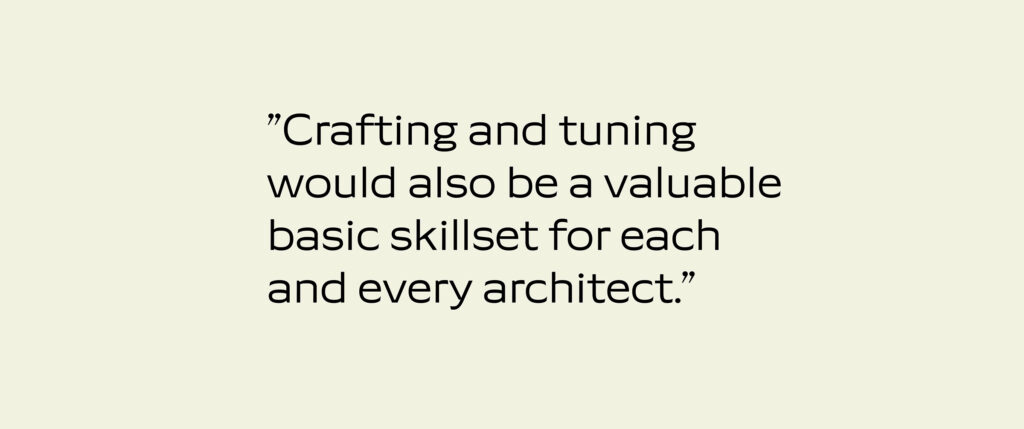Contextual Juha Leiviskä

Juha Leiviskä had an unsung ability to fit buildings to their surroundings.
Despite or perhaps due to the limited amount of writing about the work of Juha Leiviskä (1936–2023), a clear collection of often repeated recurring themes and clichés has emerged throughout the years. In particular, much has been written and said about Leiviskä’s use of daylight. However, to portray Leiviskä as some kind of wizard of optical illusions is reductionist. It fails to do justice to his versatility, reducing him as some kind of curiosity, a one-trick pony.
In addition to light, music seems to be one of the topics that tends to be mentioned almost always with regards to Leiviskä, and perhaps in a slightly misguided way. Like many others, Leiviskä sees architecture as an art closer to music than to visual arts but portrays the parallels deeper than as a mere analogy of two non-descriptive arts: “To me, a building as it stands, ‘as a piece of architecture’ is nothing. Its meaning comes only in counterpoint with its surroundings, with life and with light.”1
Although Leiviskä isn’t known as an architectural theoretician, his writings and explanations draw an image of a set of often applied design principles, that have remained valuable throughout the decades of a long career. The image can be further complemented by studying his work. Leiviskä’s buildings have an intriguing relation to their surroundings, a theme often overlooked or outright misunderstood.

Frampton’s Misapprehension
Surely the design never emerges by itself, but Leiviskä has often been able to present his design ideas and decisions as very logical and commonsensical, even self-evident. One of the recurring themes is the idea of a closed back and a more open front of a building. The earliest mention seems to be in a discussion published in 1981, where Leiviskä summoned the idea by stating that “[t]he idea is to create a sheltered neighbourhood – – without a trace of danger”.2 The principle can be clearly identified in many of Leiviskä’s designs, as it often manifests itself in distinctive planar compositions of parallel walls, perhaps most famously in the Myyrmäki Church (1984) in Vantaa.
British architecture historian Kenneth Frampton seems to acknowledge Leiviskä’s “belly versus back” principle in his essay published in 1999 but suggest other kinds of categories: “– – while on an open site, Leiviskä will opt for an orthogonal, modular system, once confronted with a tight irregular configuration he will immediately abandon his preferences and pursue an appropriately organic form.” Frampton cites Vallila Library and Daycare Centre (1991) and the entry for the Malminkartano Chapel competition (1990) as examples of the pursuit for organic form.3
However, the idea of rejecting the orthogonal and modular systems doesn’t seem to be in line with Leiviskä’s own writings. Leiviskä himself has addressed the alleged confrontation between orthogonal, modular systems and freer or organic approaches as follows: “Even though both the Nakkila Parish Centre and the church in Oulu differ from what was generally being done at the time, there are similarities: rectangularity and the use of modules as an aid to the dimensioning. Whenever more free forms appear in my work, the building still consists of regular units. – – There certainly have been designs in which ‘freedom’ has been taken further all the time, but they have never been very successful in competitions with the others. Vallila was the first work of this type which was built.” 4
Although Leiviskä was already over 50 years old by the time Vallila Library and Daycare Centre were completed, he emphasizes the consistency of his principles throughout his career: “It’s incorrect to say that I have softened in some way, or somehow gone crazy with advancing age. I have been just as crazy from the very beginning.”


Leiviskä’s involvement with the site in Vallila begun already in the 1980s, with a study of urban structure of city blocks 530, 540 and 579, commissioned by the City of Helsinki, and continued until the addition of terraced houses in 2003. According to Leiviskä, in Vallila, the plan form derives from an “inside out” driver: radial organisation of the spaces aims to orientate all the spaces to face towards the courtyard. Views are thus provided for the users, rather than towards them for surveillance purposes, as Alvar Aalto reasoned his fan-shaped libraries. Accessibility requirements lead to the volumetric variation of the spaces to be achieved through varying the heights of the ceilingrather than the level differences, as in Aalto’s library spaces or in Leiviskä’s earlier Kouvola Town Hall (1968).
It is interesting to compare Vallila Library and Daycare Centre in Helsinki with the Kouvola Town Hall. Arcades, the choice of marble as a cladding material (which in the case of Kouvola was later replaced with light granite) and the classically regular grid composition of the facade demonstrate Aalto’s and Leiviskä’s shared admiration for European urban culture and the Mediterranean. In Kouvola, most of the spaces open towards the courtyard, hence the building indeed having views to itself, as suggested by Leiviskä.
“It’s incorrect to say that I have softened in some way, or somehow gone crazy with advancing age. I have been just as crazy from the very beginning.”
Contextual Code of Conduct
In the exhibition catalogue for An Architectural Present – 7 Approaches held in 1990 Leiviskä mentions both the Kouvola Town Hall and Vallila Library under the title “Almost indispensable: a house, in which one is inside, is simultaneously seen from the outside”. The buildings indeed have essentially the same basic solution of an accessible courtyard.
However, there are seemingly obvious differences in formal execution: Kouvola Town Hall is a rather strict orthogonal arrangement in a quite loosely built post-war town centre, whilst the buildings in Vallila sit tightly packed amongst the concise townscape of the early 20th century urban fabric. Does Frampton’s analysis hold some truth after all?
Many of the projects Leiviskä had completed up until the early 1990s dealt with connecting to nature in rural or suburban settings. Since then, he has completed several projects in more urban settings, namely in the centre of Helsinki, but also in the historic centre of Bethlehem in Palestine. These do not seem to suggest Leiviskä having a tendency to “abandon his preferences and pursue an appropriately organic form”, as worded by Frampton. Culture House Sandels (2007) acts as a mediator in the joint between two existing urban grids, Swedish School of Social Science (2009) sits politely with respect to the directions of the city block where the site is located. The most concise site is perhaps that of the Ad-Dar Cultural & Conference Center in Betlehem, Palestine (2005), which still maintains the Leiviskä-esque formal language of fluidity within the grid.
So if anything, I would claim that the opposite of what Frampton suggests is true with regards to Leiviskä’s contextual strategies: buildings in urban settings respond, join and adapt to the existing grids, directions and orientations of the urban fabric, whereas on an open site buildings open up to the surroundings more freely, often in an Aalto-esque fan arrangement. Many of the unrealised projects and competition entries such as the Suntory Distilleries restaurant (1991) or the Pirkkala Church (1989) are some of the best examples of this approach, as pointed out by Leiviskä. However, for Frampton’s benefit it must be said that my condemnation of his analysis is slightly post-facto, most of the buildings discussed being completed after his text.


Invariables
Leiviskä has repeatedly emphasized the role of “invariables” as a crucial part of his design thinking and stated that “My relationship with architecture has not changed from what it was, for instance, when I gave my first lecture in the early 1970s.”5 More recently he even summoned: “The ultimate essence of architecture has over the millennia been the same: to create for people good surroundings and spaces that generate happiness.”6
Indeed, Leiviskä often refers to his teachers and mentors, and rarely presents any of his ideas as inventions of his own. One of the mentors he frequently cites is architect Aulis Blomstedt, who also emphasized the importance of the lasting values of architecture, the “invariants”. From Blomstedt were also inherited the ideas about the importance of finding the correct location for a building on a given site and that one should never build on the most beautiful place.7
Another key principle seems to be the related idea of always aiming to improve the existing setting, and selecting the appropriate means for achieving that case by case. According to Leiviskä, the role of the planned building in its surroundings may be, for example, submissive, accompanying, complementary, clarifying, unifying, strengthening or dominating.8
Although the architecture of Leiviskä’s churches has been quite widely exhibited in publications, perhaps more interesting examples of the varying contextual means are his ecclesial buildings that join existing chapels or churches.
The earliest one is the Nakkila Parish Centre (1969). The existing church from 1937 designed by Erkki Huttunen originally stood on a hilltop in otherwise quite flat landscape, dominating and in isolation, scaleless without a reference point. Leiviskä wanted the new building to appear “like a small village” to give the church the context it was missing.9 It is not difficult to see the setting of the Benedictine abbey in Neresheim raising above the roofs of the townscape below, as a possible precedent. Leiviskä frequently cites the abbey as a major influence for his church interiors, although not expressly mentioned with regards to Nakkila.
Leiviskä’s solution appears rather simple and even self-evident but is actually quite unique. Rather than merely adapting or merging into the existing setting in an attempt of architectural “harm reduction”, Leiviskä takes an active role, whilst nonetheless simultaneously emphasizing and reinforcing the monumental, tall and monolithic volume of the existing building, with a balanced contrast.
The role of the planned building in its surroundings may be, for example, submissive, accompanying, complementary, clarifying, unifying, strengthening or dominating.


Harju Funeral Chapel in Mikkeli (1997) and Church of the Good Shepherd (2003) in Pakila, Helsinki, provide examples of another approach and an interesting pair for comparison. In both cases the new extension joins directly a small Nordic classicist chapel in a somewhat similar manner, forming courtyards and entrance sequences with the existing building.
However, the hierarchy and formal language in each case is different. In Harju Funeral Chapel the extension remains in a subordinate role, supplementing and reinforcing geometries of the existing chapel, whereas in Church of the Good Shepherd the old nave has been made into a side chapel for the new church hall by tearing down the old altar wall. The solution is rarely dared in the preservationist mindset of the day, but not uncommon in the medieval times for instance, as Leiviskä points out.10 In both cases by establishing a clear sense of hierarchy and well-defined relationships, a synthesis has been achieved; an active dialogue between the old and the new.
Architecture of Common Sense
Architecture of Juha Leiviskä demonstrates, that a limited number of clear design principles, a certain kind of architectural common sense does not have to be restrictive but can manifest itself in innumerable ways. The existence of invariables does not abolish the role of the designer; it is his responsibility and measure of one’s proficiency to make judgements and evaluate how to best apply the principles in any given situation.
Leiviskä’s oeuvre is threatened by the same perils as the Modern built heritage at large: some of his work has been already demolished, after a life span of just a few decades. However, I believe that Leiviskä’s production has somewhat better odds at the architectural struggle for existence than many other buildings of the same epoch. Buildings that derive their inspiration from history and site conditions will inevitably became part of the canon of architectural history that gave rise to their formation. ↙
LARI ALA-PÖLLÄNEN
Architect, who works as a researcher.
1 Juha Leiviskä: ”A Letter from Leiviskä”. Architecture and Urbanism 295, 13.
2 Marja-Riitta Norri: ”Valon instrumentit – Keskustelu Juha Leiviskän kanssa”, Arkkitehti 2/1981, 64.
3 Kenneth Frampton: ”Landform, Fabric and Light: The Architecture of Juha Leiviskä”, in Juha Leiviskä (eds. Marja-Riitta Norri, Kristiina Paatero), Rakennustaiteen museo 1999, 22.
4 Juha Leiviskä: ”Arkkitehtonen yksinpuhelu: omaelämänkerrallisia fragmentteja”, in Juha Leiviskä (eds. Marja-Riitta Norri, Kristiina Paatero), Rakennustaiteen museo 1999, 15.
5 Juha Leiviskä: ”About Architecture”, in Matter and Mind in Architecture: The 7th Alvar Aalto Symposium, Alvar Aalto Foundation, Rakennustieto 2000, 118.
6 Anni Vartola: ”Wau! Se euforinen tunne”, Arkkitehtiuutiset 4/2016, 6–9.
7 Juha Leiviskä, ”Arkkitehtonen yksinpuhelu : omaelämänkerrallisia fragmentteja” teoksessa Juha Leiviskä (toim. Marja-Riitta Norri, Kristiina Paatero), Rakennustaiteen museo 1999, 10.
8 Juha Leiviskä: ”About Architecture”, teoksessa Matter and mind in architecture: The 7th Alvar Aalto Symposium, Alvar Aalto -säätiö, Rakennustieto 2000, 117
9 Juha Leiviskä: ”Rakennuksia ja suunnitelmia”, in Juha Leiviskä (eds. Marja-Riitta Norri, Kristiina Paatero), Rakennustaiteen museo 1999, 44.
10 Juha Leiviskä: ”Church of the Good Shepherd”, Arkkitehti 3/2004, 43.
